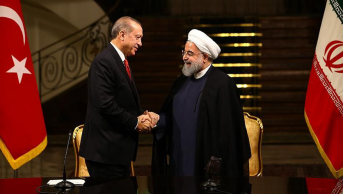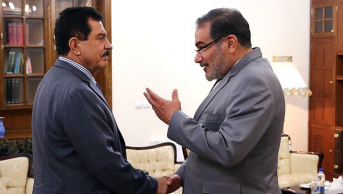ISIS Attacks in Tehran

On Wednesday, June 7, two terrorist attacks were carried out early in the morning on the Iranian parliament, and the mausoleum of Ayatollah Khomeini, the leader of the 1979 Revolution and the founder of Islamic Republic. It was reported that, four attackers with rifles, guns and suicide vests entered inan administrative buildingattached to the parliament. While security forces killed the three through the ensuing clashes, one detonated his suicide vest.It was stated that one of two people that attacked on the mausoleum of Khomeini detonated a bomb vest, and the other was shot. 17 people died and more than 40 were wounded in these twoterrorist attacks.
ISIS claimed responsibility for the terrorist attacks that occurred in Tehran for the first time after a long time.So-called news agency of ISIS, Amaq released a short video recorded by the assailantsat the time of ongoing clashes in the parliament.Like in any instance when there are many doubts and few reliable information, a lot of conspiracy theories were put forward after the terrorist attacks in Iran. Analyses concerning the attacks have entangled with conspiracy theories.
Theories...
First of all, it was questioned how an armed and bomb attack could be carried out in the parliamentary complex and the mausoleum of Khomeini, the places that are considered to have high level security in Tehran, the capital city where security measures are taken at an extremely intensive level.The selection of targets, and style of the attackshave also been discussed. Some people pointed out to the factional politics and disputes that were reshaped after the last presidential election in Iran, especially disagreements and differences between the Revolutionary Guards and the Rouhani government. Furthermore, it was found quite intriguing that both the Chairman of the Parliament AliLarijani and Iranian Supreme Leader Ayatollah Ali Khamenei referred to the attacks as “some insignificant incidents” in their first reactions.
Even though ISIS claimed responsibility for the terrorist attacks, some people associated the attacks with Trump administration’s policy towards Tehran. Indeed, in his visits to Saudi Arabia and Israel on May 21-22, US President Donald Trump, who is known for his anti-Iran rhetoric, accused Iran of supporting terrorist organizations and destabilizing the Middle East, and stated that the Iranian regime should be isolated. Besides, it was also pointed out that the attacks in Tehran took place a short while after Michael D’Andrea, who is claimed to have played an effective role in the operation that killed al-Qaeda leader Osama bin Laden, has taken charge of the Iran file in the CIA. The Revolutionary Guards released a statement after the incidents where it reminded that the terrorist attacks occurred a short time after the meeting between US President Trump and the ‘reactionary’ government leaders in the region, and it has claimed that these countries played a role in theterrorist attacks. In the same line, General Hussein Salami, Deputy Commander of the Revolutionary Guards,argued that the terrorist attack was a result of a joint project between Saudi Arabia, Israel and the USA that aimed to destroy Iranian power.
Most of the statements made by Iranian sources after the terrorist attacks targeted the Saudi Arabia. In a televised speech on May 3, Saudi Minister of Defense and Deputy Crown Prince Mohammed bin Salmanhad stated that Iran had been waging a war against his country, but ‘Saudi Arabia would not wait idle for the upcoming war, but carry the conflicts to Iran instead’. On June 7, only a few hours before the attacks, Minister of Foreign Affairs Adel al-Jubeir spoke to al-Arabiya TV, asking that Iran should be punished for its interventions in the region and its support for terrorism. In a letter to the Security Council, Permanent Representative of Iran to the United Nations, Gholamali Khoshroo reminded of the speeches of Prince Mohammed and al-Jubeir and underlined that the attacks took place a very short time after these statements were made.
Minister of Foreign Affairs, Zarif, indirectly targeted Saudi Arabia in the message he gave on twitter: ‘Terror-sponsoring despots threaten to bring the fight to our homeland. Proxies attack what their masters despise most: the seat of democracy.’Iranian Supreme Leader Khamenei released a message of condolence for the victims of the attack. In his message, he stated that the terrorist attacks ‘showed the hostility of the agents of imperialism against noble Iranian nation and everything connected with the revolution’. He continued his message as follows: ‘the most absolute consequence of the attack will be nothing but the increase in the hatred against US government and its regional agents such as Saudi Arabia.’
Despite the harsh criticism against the Saudi Arabia, Minister of Intelligence Mahmoud Alavi indicated that ‘it was too early to say that Saudi Arabia was behind the attack’ and the studies on this issue was still going on. Having claimed that there is an overt relationship between the Saudi Arabia and terrorist organizations in Syria and Iraq, Alavisaid that ‘currently they have no evidence regarding the role of Saudi Arabia in the attacks.’
ISIS – Iran Showdown
Those who try to explain the terrorist attacks in Tehran within the framework of factional politics, Iran-US relations, or regional developments either underestimate the fact that the attacks were perpetrated by ISIS,or implicitly assume a relationship between ISIS, the USA and other regional countries. However, one of the ideological motivations ofISIS is to stand against ‘rafidi’ and ‘Safavid Iran,’ and fight the Shiites. Iran also claimed that it has been fighting against terrorism across the borders. However, those who have been skeptical of Iranian policy towards Middle East policy, and that have dubious ideas about ISIS draw attention that ISIS had not carried out a serious attack in Iran despite their ostensible animosity, and they questioned why ISIS did not take actions in Iran? Now, the recent attacks in Tehran, the capital of Iran, took place in two places which are symbolically significant for Iranian regime revealed that Iran is not exempted from ISIS attacks.
Although the Tehran attacks are the most effective attempt of ISIS, they were not the first ISISplots in Iran. Minister of Intelligence Alavi indicated that ‘more than one hundred terrorist attacks had been prevented within the last two years’. In a video released in Persian in early March 2017, ISIS claimed that Iran discriminated against Sunni minority and called ‘the Sunni to rebel against the Shiite Iranian regime’.
Additionally, apart from the external threats, some segments of Iranian population are anxious for ethnical-sectarian reasons.Given the obstacles before activities of political associations, some ethnical-sectarian groups have taken arms and so far carried out various armed attacks against the Iranian government.Moreover, ISIS has been trying to reach out ‘the Sunnite Kurdish, Baluchi and Arab people’ for a while, and recruiting new fighters among those people. Indeed, it was revealed that all of the assailants who carried out the Tehran attack were Iranian citizens recruited by ISIS, and previously fighting for the terrorist group in Iraq and Syria.
The attacks in Tehran will lead the Iranian security policies and security institutions to the forefront, independently from the perpetrators and reasons. It is not expected that Iranian regional policy will change considerably. In his statement after the attacks, Khamenei said that Iran would proceed on its own way and the terrorist attack would only serve to increase the determination of the Iranian nation. Indeed, Khamenei utilized these incidents to justify Iranian regional policies and said: ‘had Iran not stoodagainstthehotspot of terrorism in theregion, thecountrywouldhavefacedmore severe problems.’ Therefore, Iranian government is likely to exploitthe Tehran attacks in order to weaken growling resentment inside the country against policies towards the Middle East, and to strengthen the ‘legitimacy’ of its regional policies.











